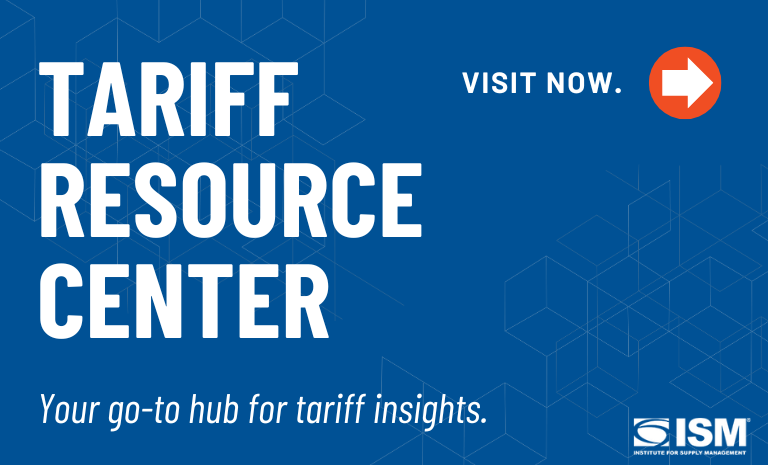Supply Chain Roundtable: Geopolitical Turmoil and Disruptions (Again)

This is the sixth time the monthly roundtable of experts from Institute for Supply Management® (ISM®) has convened, and as one panelist pointed out in this edition, potential disruption from a breaking news event has been a regular question topic.
As supply management professionals have learned over the last five years, certain risk management principles will serve their organizations well amid any disruption. However, every disruption is different, and while the full ramifications of the Israel-Iran conflict are still to be determined, it will likely have significant impact on oil supply and prices.
The panel — Thomas W. Derry, ISM CEO; Jim Fleming, CPSM, CPSD, Manager, Product Development and Innovation; Paul Archiopoli, C.P.M., CPSD, CPIM, CMFGE, Subject Matter Expert; and Michelle Rohlwing, MBA, Manager, Product Development, Innovation and Learning — also discussed how to make the best procurement business case and takeaways from the ISM World 2025 Annual Conference in Orlando, Florida, earlier this month.
Q: The erupting hostilities between Israel and Iran serve as another reminder of the impact that geopolitical turmoil can have on supply chains. Does the “fog of war” make such conflicts the most challenging potential disruption to deal with? How can organizations mitigate the impact — for example, Iran potentially restricting the Strait of Hormuz — on supply chains already slowed by tariff ramifications?
Derry: One possible fallout from the Iran-Israel conflict involves the oil market. Despite U.S. sanctions, China is a major customer of crude from Iran. If that supply were disrupted, then China would have to replace from elsewhere. Russia could be an obvious source, given the strategic collaboration between those two countries. But it has the potential for increasing prices for petrochemicals and derivatives worldwide. So, I’d be watching the oil markets closely if, for example, I am an ethylene buyer.
Archiopoli: It’s far too early to speculate on the impact of the Iran-Israel conflict, as the range of possible outcomes is very broad — from “nothing” to nuclear conflict launched from either party. The Strait of Hormuz is highly unlikely to close, given the heavy U.S. Navy presence in the region. My personal view of a “most challenging” disruption would be a total shutdown of supply lines that are critical to U.S. health and safety, along with items vital to national defense. I worry far more about supply chains like pharmaceuticals and rare earth minerals.
Rohlwing: I agree with Paul — it is too early to speculate at this point. In conversations with practitioners in my network, most have said that they are in a wait-and-see mode for this potential risk. As always, supply chains need to do what they can to be agile and resilient. The Strait of Hormuz is known for handling a significant amount of global oil shipments. Companies affected should be analyzing their data to determine the best strategies and scenarios to mitigate this risk so they can change directions if needed. Shipping companies should check their contracts to see if they can change their route in case of risk.
Fleming: We are seeing a pattern over the last number of months within these Roundtable discussions: There is always some crisis that has some potential impact on global supply chains. Now, the world is focusing on the Iran-Israel conflict, which is the third major war or conflict over the past three years, with Russia-Ukraine and Isreal-Hamas. In recent years, we’ve contended with a pandemic, tariffs, rare earth element shortages, geopolitical tensions, climate-related disasters and many other disruptions. I am almost certain we will be faced with some new or expanding crisis in the near future. Supply chain professionals must continue to invest in capabilities and talent that focus on revenue generation and preservation. There are very sophisticated (and affordable) technologies that can aid in risk identification and scenario planning. Supply chains and their professionals must be resilient and make risk management a standard way of doing business. “There’s always an alien battle cruiser, or a Corillian death ray, or an intergalactic plague,” said Agent K in “Men in Black.” Tommy Lee Jones’ character added that people never know about those threats because the men in black prevent them and maintain peace. Supply chain professionals are similar to the men in black.
Q: Gartner research has found that most supply chain organizations lack a formal artificial intelligence (AI) strategy, due in part to doubts about ROI from above. In general, what’s the best way for procurement to make its investment case to executives, for AI or any initiative?
Archiopoli: The ROI and business case for procurement investment in AI is the same as for any other investment: (1) personnel cost reduction, (2) purchase price cost reduction, (3) logistics and operations cost reduction, (4) inventory turns increase and (5) more effective use of working capital. Such a business case would have to show the investment will deliver a tangible return within the time and financial requirements of the organization.
Rohlwing: The best way to implement any major strategy is to follow change management principles. Know your stakeholders, gauge their biggest pain points and find a way to implement AI where it can make the biggest difference. Start small, so that the investment is modest but, if strategically placed, can make the biggest impact. It is always good to obtain case studies with similar scenarios in which implementation provided cost savings. Lastly, starting small often makes it easier to gain buy-in and expand.
Fleming: At ISM World 2025, Patrick Marlowe of Google spoke about AI adoption rates being higher for companies that take a planned approach. First, identify a problem, then define business value, select technology and institute governance. The second step is critical. It’s very important to not only show the connection to business value, but also articulate it using the language of senior leaders. Supply chain professionals must also be business professionals. Forbes recently published an article, “19 Ways To Measure The ROI Of Your AI Initiatives,” that is just one example of how many ideas are available through simple web searches. We need to remain curious, informed and connected to business value.
Derry: We have conducted research at ISM that shows that the top quartile of supply management teams produces four times the ROI than the bottom quartile. The bottom quartile still returns 150 percent in ROI to the organization, but top-quartile teams return more than 600 percent. And the kicker is that the high-performing teams get that return with 60 percent less head count. How do they do that? With better training, tools and processes. So, I would be looking for AI use cases that enable my team to be more productive with less head count. I know there’s a train of thought that AI will perform more mundane tasks, freeing humans to do more strategic work. There’s probably a grain of truth to that. But we should also accept that AI can in fact replace some existing positions.
Q: For those of you who attended ISM World 2025, what was your most valuable experience or learning from the Conference?
Fleming: I was fortunate to moderate the discussion panels with Trailblazer Award winners. Their success stories of overcoming complex supply chain hurdles were amazing. One that stood out was a pharmaceutical company delivering life-saving medicines to people in flood-stricken northern India. This humanitarian effort leveraged drone technology over large territories. Several complex variables had to be dealt with, including critical temperature control of medicines, government flight path approvals, landing and takeoff zone safety, and shifting weather conditions. But all of that cooperation and innovation paid off, setting new standards in risk management within a supply chain.
Rohlwing: The best part of ISM World 2025 for me was meeting in person all of the ISM members and volunteers who I have spoken with virtually over the past year. It’s always great to connect with people in real life. I found the breakout sessions to be super impactful and interesting. My favorite session was “Sustainable Procurement in Action,” where I learned that ongoing collaboration with suppliers helps embed sustainability into day-to-day operations, driving improvements, solving challenges and sharing innovations over time. Lastly, former U.S. Commerce secretary Gina Raimondo’s discussion of the CHIPS and Science Act during her keynote session gave me a deeper understanding behind its effort to strengthen the U.S. semiconductor industry.
Derry: My biggest takeaway was the conversation that was almost exclusively around tariffs and how they disrupt supply chains. But I also learned that in six months or less, organizations should have clarity and can fully deploy their mitigation strategies. While we will likely continue to live with tariffs as a new fact of life, we will have learned how to deal with them. We will be on to solving other problems by 2026!

